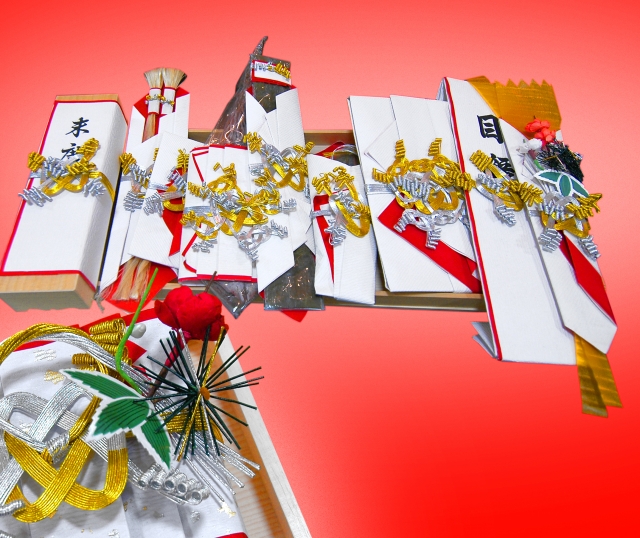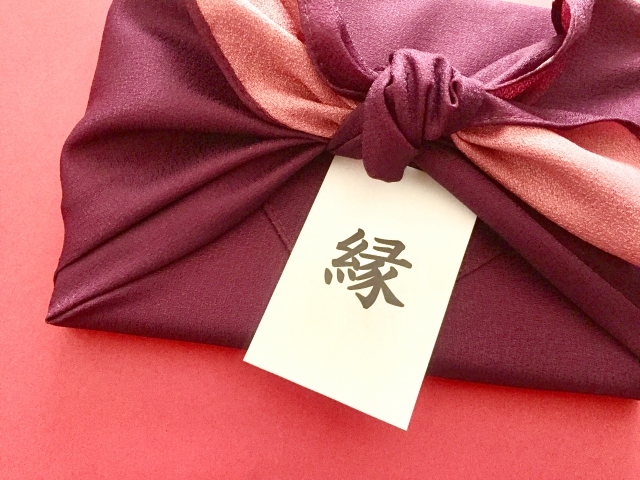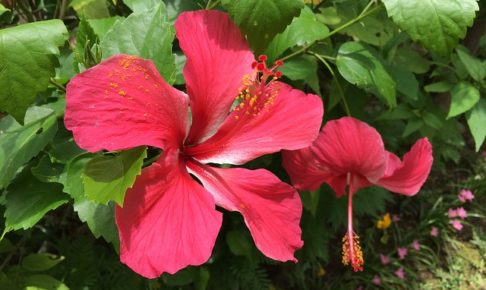こんにちは、ノ~チン(@NozomiJapanese)です。
今日は、「結納」を英語で説明してみようと思います。
結納
いつものごとく、まずは日本語で結納を説明するとどうなるか見ていきましょう。
結納の日本語での説明
- 結納とは婚約を公にするための日本の伝統的な儀式です。
- 多くは、結婚式の3~7ヶ月前の吉日に行います。
- 両家の間で、結納金や結納品を取り交わします。
- 結納金は一般的に50~100万円が多く、新郎側が新婦の家に対し贈ります。
- 新婦が嫁入り道具を揃えるために贈られるお金です。
- 元々はお金ではなく、着物や帯などの花嫁衣装が贈られていました。
- 正式な方法では、仲人が両家を行き来して金品を贈ります。
- 現在は簡略化して(仲人を省略して)、男性側が女性の家を訪問して金品を贈る、または交換することが多いです。また、ホテルやレストラン、料亭で行うこともあります。
- 地域によって形式が異なり、大きく「関東式」と「関西式」「九州式」の3つに分けることができます。
- 関東式では、男女ともに結納品を用意し、互いに結納品を取り交わします。結納金については、女性側が男性側の半分の価値に当たる物品を返す「半返し」の習慣があります。
- 関西式では、結納品を送るのは男性側のみです。女性側は後日、貰った金額の一割程度の金額を返礼として持参します。
- 九州式は、関西式と似ていますが、結納の前に男性側が女性宅にお茶や、酒一升、鯛1尾を持参する風習があります。
- とはいっても、今日では約2割の人しか結納をしません。
- その代わりに両家で食事をしながら親兄弟を紹介する、というスタイルが多く(8割)を占めるようです。
重要な用語
| 日本語 | 英語 | 発音 |
| 婚約 | engagement | エンゲィジメント |
| ~を公にする | make ~ official | メイク ~ オフィシャル |
| 伝統的な | traditional | トラディショナル |
| 儀式 | ceremony | セレモニー |
| 吉日 | a lucky day | ア ラッキー ディ |
| 両家 | the bride and groom families | ザ ブライド エンド グルーム ファミリー |
| 嫁入り道具を揃える | bridal array | ブライダル アレイ |
| 花嫁衣装 | wedding dress | ウェディング ドレス |
| 仲人 | go-between | ゴービトゥィン |
| 簡略化して | is simplified | イズ シンプリファイド |
| 地域 | region | リージョン |
| 返礼として | in return | イン リターン |
発音は辞書を引くのが面倒な人のために参考までに書いています。
正確な発音とは異なってしまっているので、正確なものを知りたい人は、辞書で確認くださいね!

「結納」の英語での説明
- 結納とは婚約を公にするための日本の伝統的な儀式です。
Yuino is a Japanese traditional engagement ceremony to make an engagement official. - 多くは、結婚式の3~7ヶ月前の吉日に行います。
In many cases, it is held on a lucky day of 3 to 7 months prior to the wedding. - 両家の間で、結納金や結納品を取り交わします。
Between the bride and groom families, engagement money and gifts are given or exchanged.
The money is called “Yuino-kin (engagement money)” and the gifts are called “Yuino-hin (engagement gifts)”. - 結納金は一般的に50~100万円が多く、新郎側が新婦の家に対し贈ります。
The money is usually somewhere between 500,000yen to 1,000,000yen (5,000US$~10,000US$) and it is given from the groom family to the bride family. - 新婦が嫁入り道具を揃えるために贈られるお金です。
The money is given to the bride for bridal array. - 元々はお金ではなく、着物や帯などの花嫁衣装が贈られていました。
Originally wedding dress such as kimono and kimono belt (obi in Japanese) were given instead of the money. - 正式な方法では、仲人が両家を行き来して金品を贈ります。
In an official way, go-between called “Nakodo” visits both families’ house to give or exchange the money and gifts. - 現在は簡略化して(仲人を省略して)、男性側が女性の家を訪問して金品を贈る、または交換することが多いです。また、ホテルやレストラン、料亭で行うこともあります。
Nowadays, it is simplified and often omitted the go-between. The groom and his family visit the woman’s house to give or exchange the money and gifts. Sometimes the ceremony is even held at a hotel, restaurant or Ryotei (a Japanese-style restaurant). - 地域によって形式が異なり、大きく「関東式」と「関西式」「九州式」の3つに分けることができます。
The style differs in regions. There are mainly following three styles, “Kanto style”, “Kansai style” and “Kyushu style”. - 関東式では、男女ともに結納品を用意し、互いに結納品を取り交わします。結納金については、女性側が男性側の半分の価値に当たる物品を返す「半返し」の習慣があります。
With “the Kanto style”, both man and woman’s family prepare the engagement gifts and exchange them to each other. For the engagement money, there is a custom called “Hangaeshi (half return)” that woman’s family returns some gifts at half value of the given money. - 関西式では、結納品を送るのは男性側のみです。女性側は後日、貰った金額の一割程度の金額を返礼として持参します。
With the “Kansai style”, only man gives engagement gift to woman. At a later date, woman’s family brings about 10% of the money of given gifts in return. - 九州式は、関西式と似ていますが、結納の前に男性側が女性宅にお茶や、酒一升、鯛1尾を持参する風習があります。
The “Kyushu style” is similar to the “Kansai style” but there are customs that man’s family brings tea, 1.8 liter of sake and one sea bream before engagement ceremony. - とはいっても、今日では約2割の人しか結納をしません。
However only about 20% of the people hold Yuino, the engagement ceremony, nowadays. - その代わりに両家で食事をしながら親兄弟を紹介する、というスタイルが多く(8割)を占めるようです。
Instead, many people (80% of the people) choose the style to get both family together and introduce the family members to each other over meal.
この記事が役に立った、面白かった、という方はfacebook、twitter、ブログでぜひシェアしてください!
















